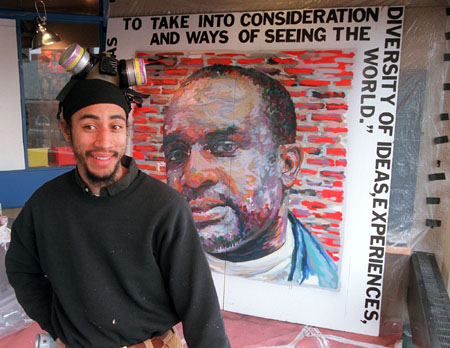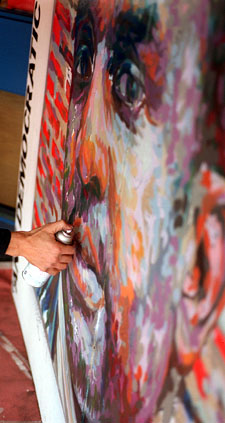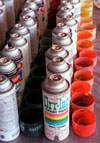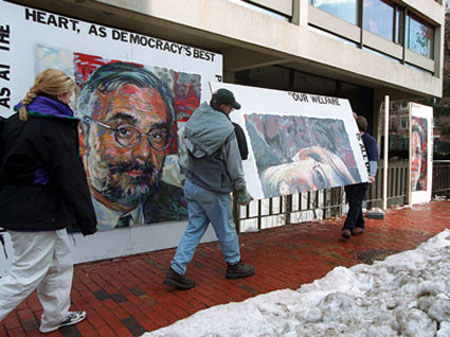Politics and paint make a great mix

Staff photos by Rose Lincoln
Brett Cook-Dizney’s artwork stinks. The spray-paint fumes wafting through Gutman Library this week are proof of that, but what’s really happening inside the glassed-in, makeshift studio demands appreciation far beyond a single sense or category.
“Some people write about this as ethnography,” says Cook-Dizney of one of the many labels placed on his passion. “Someone else will be like, ‘Well this is “murals,” because he does it outside and it comes from the community art perspective.’ Someone else is like “high art!” He shows in museums and he shows in galleries, and that’s all we know.’

“I’m all of those things,” declares Cook-Dizney. “I’m a latticework of all those things.”
The Graduate School of Education’s (GSE’s) description of the New Yorker’s four-day Harvard residency applied the term “hip-hop artist,” to which Cook-Dizney shrugs and replies, “whatever.” Rubbing his paint-stained fingers together, the artist explains his indifference. “I see value in ‘hip-hop,’ so let’s be clear with that. It’s more about (people) trying to essentialize something that’s more complex.”
Cook-Dizney talks about his artwork in terms of poetry, politics, history, and passion; and ultimately as a celebration of the power of individuals and the communities they create. “Desegregation” is the title of his artistic profile of the Harvard community. Cook-Dizney describes his multimedia project as a vehicle for “helping us all become more humanized through dialogue about these ideas.”
The subjects for the larger-than-life triptych are a faculty member, a staff member, and a student: Marcelo Suarez-Orozco, Karen Maloney, and Frank Tuitt, respectively. The artist interviewed the subjects on the topic of desegregation, and then photographed them. The photos were transformed into line drawings, which were then projected onto large panels. The subjects used the projections as guides to trace their images onto canvasses. Those tracings became the base drawings for the 8-foot-by-8-foot spray-painted portraits Cook-Dizney would eventually bring to life.
“First of all we’ve got these different people from different positions here at the University to work together. There’s a kinship already from being in this thing together. And then the different parts of it have brought other people in. So like when Frank was drawing himself, his friends came, or Dottie [the GSE’s Dorothea Engler] came and drew some of it. So staff people are drawing or a professor comes and helps a little bit with someone else.” The days of group art and conversation culminated with Cook-Dizney’s spray-painting finale.

Accompanied by a John Coltrane CD and sporting a double-barreled gas mask and protective turban, Cook-Dizney steps forward, sprays a few colorful dabs or swipes, then steps way back. His head is cocked to one side as he backsteps, taking in the enormity of the piece. He reflexively shakes the paint can with his right hand, while checking the now flat-looking photograph in his left against the gigantic, vibrant creation before him. His rhythmic nodding could be self-approval, or keeping time to Coltrane. It’s tough to tell. The work is good, and the music is good, so maybe it’s both. Over the course of about an hour nearly a dozen GSE affiliates peek in at Cook-Dizney and the evolving piece, offering encouragement or congratulations.
The three works hang outside the Gutman Library accompanied by the full text of the interviews. When asked whether he was worried about exposure of the art to the elements and the public, Cook-Dizney said that making the work accessible is worth the risk. “Art has always been this elitist thing … separate,” he explained. This is “… about dialogue. It’s about sharing ideas.” That pungent odor still hovering inside Gutman Library is the smell of Cook-Dizney’s success.
Share this article





